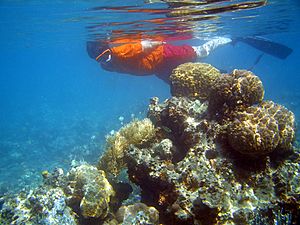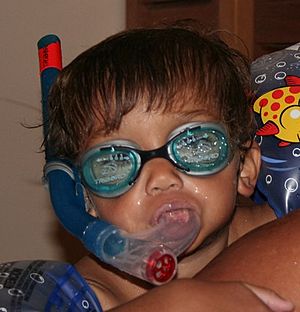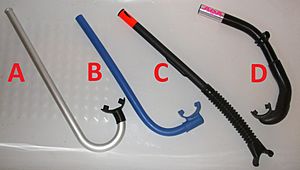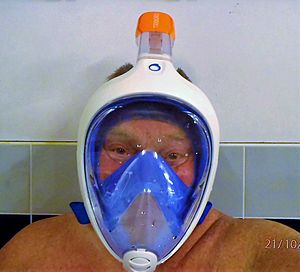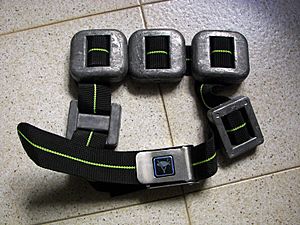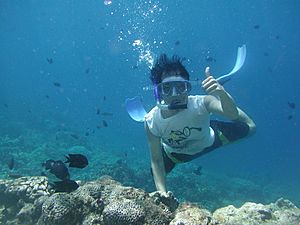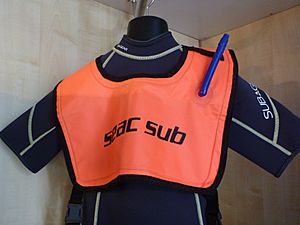Snorkeling facts for kids
Snorkeling is a fun way to swim on or through water using special gear. You wear a diving mask to see clearly underwater and a snorkel to breathe. Sometimes, people also use swimfins to swim faster and a wetsuit if the water is cold. Snorkeling lets you see amazing underwater life up close in its natural home.
It's a very popular activity, especially in warm, tropical places. Many people love snorkeling because it's relaxing and doesn't need as much gear or training as scuba diving. Scuba divers also use snorkels when they are on the water's surface. Snorkeling is even used in some underwater sports and by search and rescue teams looking for things in the water.
Contents
Snorkeling Gear: What You Need
Here's the main gear you need for snorkeling:
- Snorkel: This is a tube that helps you breathe when your face is in the water. It can be a separate tube or built into a full-face mask. Most snorkels are shaped like an "L" or "J" with a mouthpiece at the bottom. You hold the mouthpiece in your mouth. The top of the tube stays above the water so you can breathe air. It often attaches to your mask strap.
- Diving mask or swimming goggles: A diving mask covers your eyes and nose. Some masks cover your whole face. With a full-face mask, you can breathe through your nose or mouth because the snorkel tube is part of the mask.
Here is some extra gear you might want:
- Swimfins: These look like big shoes with flat ends, similar to a frog's foot. They help you push more water with each kick. This makes you swim much faster and easier.
- Exposure protection:
* Wetsuits: These suits keep you warm in cold water. * Dive skins or rash vests: These are lighter suits that protect your skin from the sun's UV rays, rashes, and stings from small sea creatures.
- Weightbelt: This belt has lead weights on it. It helps you sink if you want to dive deeper for a short time, like when free diving. Weightbelts have a quick-release buckle. This lets you take it off fast in an emergency.
- Snorkeling vest: This is a special floatation device. It helps you float easily and stay balanced face down in the water. It's like a life jacket but designed for snorkeling.
How to Use Your Snorkel
When you snorkel, you put the snorkel's mouthpiece in your mouth. Make sure the top of the tube is above the water. This way, you can breathe air freely.
What if water gets into your snorkel tube? Don't worry! You can clear it out.
- Blast clearing: Make sure the top of the tube is out of the water. Then, exhale sharply and quickly. This will shoot the water out of the tube.
- Displacement clearing: This works when you are coming up from being underwater. Just before you reach the surface, tilt your head back. Then, exhale slowly until you break the surface. You can then face down and take your next breath.
Enjoying Snorkeling Safely
Snorkeling is more of a fun, relaxing activity than a competitive sport. You don't need special training to snorkel. You just need basic swimming skills and to be able to breathe through the snorkel.
For safety, many groups suggest you never snorkel alone. Always go with a "buddy," a guide, or a tour group. If you want to try free diving (holding your breath to go deeper), it's a good idea to get some training first.
Taking pictures underwater has become very popular. Since the early 2000s, millions of underwater photos have been shared online. Scientists even use these pictures to study sea life!
Staying Safe While Snorkeling
Many snorkelers wear snorkel vests to help them float. They also wear wetsuits, dive skins, or rash guards. These protect them from cold water, sun, stings, or scrapes.
One of the biggest dangers for snorkelers is boats and jet skis. These vehicles can be hard to see from the water. Boaters might not see you because only your snorkel tube is visible. To be safer, wear bright or reflective colors. You can also use a dive flag to help boaters spot you.
It's also important to drink plenty of water. Snorkeling can make you dehydrated. Staying hydrated helps prevent cramps too.
Coral reefs are beautiful but can be delicate and sharp. Some corals can even sting. Wear protective gloves and be careful around coral. This helps you avoid cuts or scrapes that could get infected.
Be careful when you are near marine life. Animals like seals and sea turtles might seem friendly. But they can get scared if you get too close. Many snorkeling guides say, "observe but don't touch" when you are near sea creatures.

Where to Go Snorkeling
You can snorkel in almost any body of water. But the best places have small waves, warm water, and interesting things to see close to the surface. Shallow reefs are great for this. You can explore deeper reefs, but you'll need to hold your breath. These deeper spots can be more challenging.
Other Water Activities Like Snorkeling
- Bog snorkeling: This is a unique sport popular in the United Kingdom and Australia. You snorkel through a muddy trench!
- Finswimming: This is a competitive sport where swimmers use special fins and snorkels to swim very fast.
- Free diving: This is diving underwater while holding your breath, without any breathing equipment. It can be a sport.
- Scuba diving: This is diving underwater using a special tank of air that you carry with you. It's a popular hobby.
- Spearfishing: This is fishing with a spear, often done while using snorkeling gear. People do it for sport or to catch food.
- Underwater hockey: A team sport played in a swimming pool. Players use snorkeling gear, sticks, and a puck.
- Underwater rugby: Another team sport played in deeper swimming pools. Players use snorkeling gear, baskets, and a ball.
Fun Facts About Snorkeling
- Some people think snorkeling started around 350 B.C. The Greek thinker Aristotle saw an elephant underwater, using its trunk to breathe.
- Snorkeling is a very popular way to have fun and relax.
- You don't need to be a strong swimmer to enjoy snorkeling. You can use a flotation device to help you float.
- The Great Barrier Reef in Australia is one of the most famous places in the world for snorkeling.
- The Maldives has super clear water and lots of amazing marine life. It's a dream spot for snorkelers!
- Even though snorkels let you breathe with your face in the water, it's good to look up often. This helps you make sure you aren't swimming too far from shore or your boat.
- Sharks usually don't come close to people who are snorkeling.
- It's a good idea to learn how to clear your snorkel before you start snorkeling.
- Snorkeling can be very peaceful. You can just glide slowly along the water's surface.
See also
 In Spanish: Esnórquel para niños
In Spanish: Esnórquel para niños


